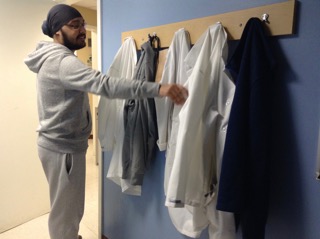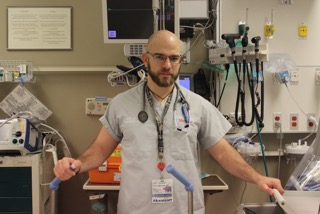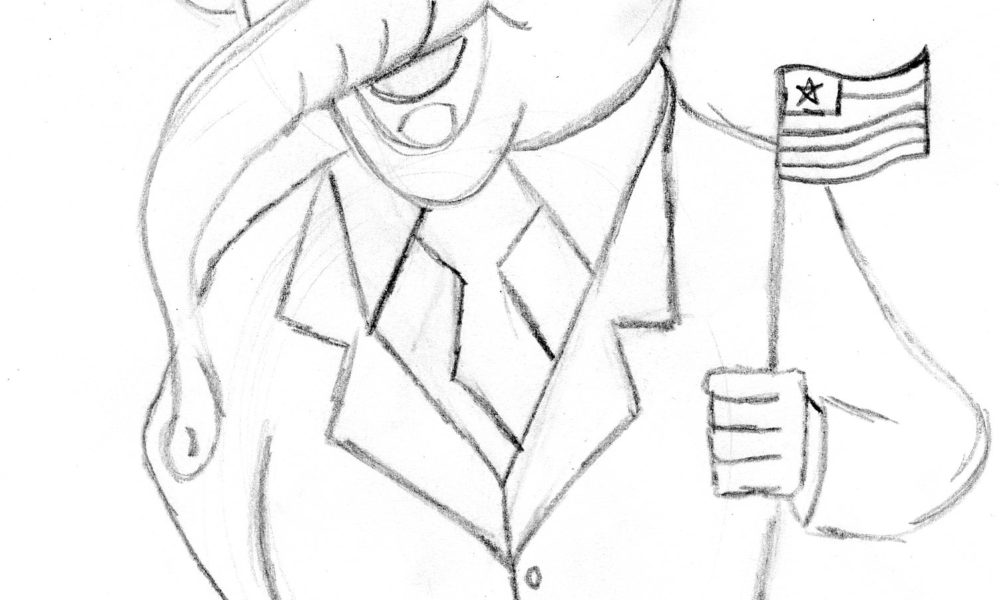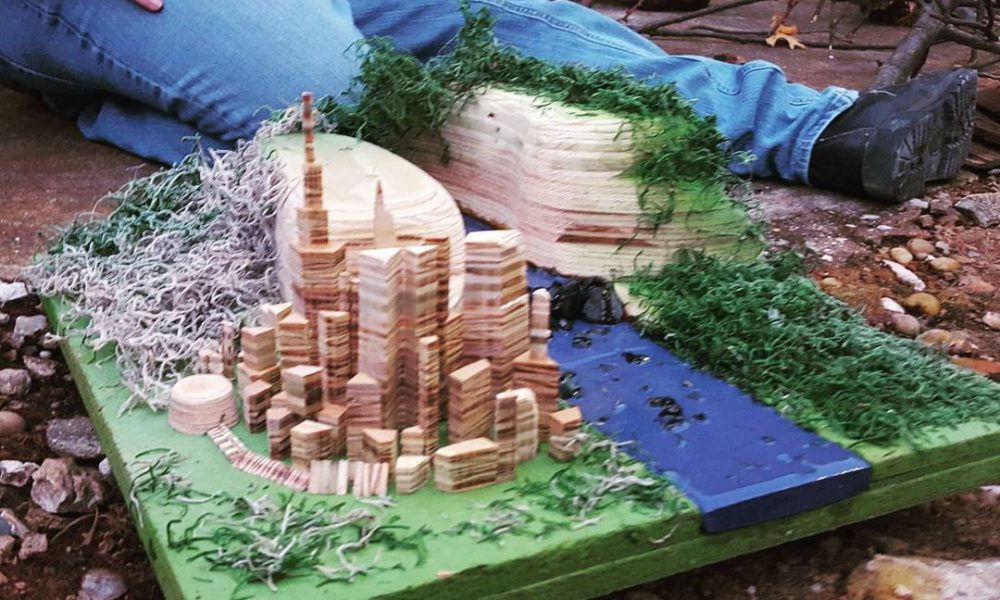One man’s story begins in Jalandhar, India with a 15-year-old boy riding a red bike. A traffic circle midway between Guru Amar Dass Public School and his home. A car accident.
The second man’s story starts in New Orleans with a superhero. A woman called “Lovie” and a cat named Homie. A desire to save lives.
The little boy on the bike grows up to become Dharampreet (Dharam) Singh, M.D and the New Orleans kid is now Timur Alptunaer, M.D. and R.N. But their paths toward becoming doctors are more complicated. The two men encounter death first hand and grasp what it means to be mortal. And along the way, they discover the meaning of compassion.
The Accident
It was a hot, July afternoon in 2004. Summer break had just ended, and it was either day one or two since schools across Jalandhar had fallen back into rhythm.
Pedaling home from school, Dharam and his friend Sandhu paused at a traffic signal at the Football Cross Section. The light blinked from red to green. Dharam and Sandhu turned right, when suddenly everything went blank.
A few days later, Dharam finally opened his eyes. Or maybe it was the doctors trying to pry them open.
“What do you see?” asked one of the doctors, peering at Dharam.
Dharam’s eyes lifted towards his mother, who was standing and weeping before his bandaged body, patched up on a hospital bed in the Intensive Care Unit. “Oh, I see you,” he mustered out. And then his memory fades into fragments of reality and imagination.
Dharam never witnessed the accident, but Sandhu, who suffered only a few scrapes, did.
A small pickup truck had rammed into Dharam, pinning him under the vehicle. He had seven cranial fractures.
“I was 15,” he now says in protest. “No one wears a helmet.”
About six weeks after the accident, Dharam was discharged from the ICU. But before, Dharam, too weak to walk to the bathroom mirror alone, had not seen what his post-accident body looked like. The day before Dharam was discharged, he finally saw his face.
It had become a Halloween mask – “the inside of a pumpkin,” he describes. Stitches knit together sheets of skin, starting from his right eyelid, cutting across his right eyebrow, and widening towards the zenith of his head in an inverted triangle.
Nor did the rest of his body escape injury.
His stout, 180-pound, 5-foot-11-inch frame had shrunk to a 95-pound stick. Because he had suffered from so much facial trauma, the doctors were afraid to feed him through a nasogastric tube, a flexible tube that would’ve protruded into one of his nostrils. It was too risky.
But Dharam was not too concerned about the pain. What he truly couldn’t ignore was the explanation behind his head trauma.
He argued with his doctors.
“You had fractures,” they told him.
“You’re lying to me,” Dharam retorted back. There was no plaster on his head. He was not immobilized, either.
The doctor lightly touched his damaged head, indicating the injured locations – the frontal bone and the zygomatic bone.
“Then the other ones, the ethmoid and sphenoid, are behind your eyes,” the doctor told him.
There was a pause.
“You think I’m that stupid? There are bones behind my eyes? There are no bones behind my eyes,” he remembers saying, though now he chuckles at the 15-year-old boy who knew nothing of anatomy, yet dared to challenge a certified physician.
If he had broken his leg, the injury probably wouldn’t have been a big deal.
“Here’s a cast. Don’t move it. Okay. You realize that makes sense. That makes sense to a 15-year-old me,” he says now. “But when you fracture an ethmoid bone and you’re like, ‘What the fuck does that mean…’ you get in this rhythm of ‘I want to know what that is.’ You kind of figure out what that is. And then you want to learn more.”
The Doctor in a Hoodie

More than 12 years have passed since the accident. Dharam, the 15-year-old boy, is now a 27-year-old third-year neurology resident.
“He’s kind of soft-spoken,” says Kelly Tisovic, a fellow resident who has known him for two-and-a-half years. “But I wouldn’t say he’s shy by any means.”
It’s a Saturday afternoon in October – one of his few days off at Stony Brook University Hospital.
He arrives at the hospital in a light gray hoodie – his customary apparel – instead of a white coat. He’s not very keen about donning his white coat, or, for that matter, wearing a tie.
“Well, maybe not this one,” he says, holding up one ID picture on his keychain holder, featuring Dharam with a tie. “Or this one,” he says, bursting into laughter as he points towards another ID. “I wore a tie and suit on my wedding. That’s all you can expect from me.”
He reaches the 13th level of the hospital, the neurology floor . – his home floor.
Rooms for patients dot the long, curving hallway. Men and women, usually with bandaged heads, recline in bed, some with a companion sitting beside them. The low hum of their TVs becomes muted by the chatter of nurses and hospital staff, along with the occasional beeps of scattered medical equipment. “Get well soon,” sings a partially deflated balloon attached to a basket on the main desk.
A list of neurology residents and fellows for 2016-2017 hangs on the staff wall. There’s Dharam, sporting a dark blue turban, rimless eyeglasses, a mustache and a tie – his trademark hoodie temporarily gone for Picture Day. Beside his name and phone number is a heart scribbled in black pen.
A hospital employee spots him. “You look very healthy,” she exclaims.
“Yeah, I’m not working.”
“Good for you… He’s a great guy. We all like him.”
“You don’t have to say that,” Dharam says sheepishly.
“I don’t have to say anything,” she reminds him as he chuckles.
The days when Dharam is on call are different. He wakes up around 5:15AM. He rarely eats breakfast. It’s just not his thing.
“What’s up, doc?” one of the hospital guards will typically ask Dharam.
“Ah, same shit. Different day.”
There have been many days in his four years of medical school and two-and-a-half years of residency – like the first time a patient called him “Doctor.”
“I’m like, ‘WHAT? Wait, wait – who are you talking about – me? In my short white coat who doesn’t know anything?’” Dharam says. “It’s humbling, but it also… it’s amazing.”
There’s the day he saw his first dead patient.
Dharam, still a medical student in his first or second year, remembers shadowing his superiors during an ER rotation. Suddenly, there was an announcement: Code blue. Cardiac arrest.
A black man in his 20s or 30s – a shooting victim – was rushed into the hospital. Blood poured from a gunshot wound to his thorax and abdomen, but air did not leave his mouth.
Doctors joined the staff already pumping on his chest. Standing at the foot of the operating table, one doctor commanded instructions. He was mechanical, methodical – a drill sergeant.
For 10 minutes, this stranger was pumped with life – two people pushing life back into his heart, two trying to clear his airway, one managing the liquids and medication coursing through his veins, all desperately trying to keep this one man alive. But it was too late. 10 minutes later, the three dreaded words were announced: “Time of death.”
The medical scribe confirmed the time of death with the attending, and within minutes, the beehive of activity disappeared. Only Dharam, standing ten feet away from the man, remained.
Dharam looked at the patient. He was neither blue nor pale, like the bodies Dharam had seen in the movies. He drew closer to the stranger’s right side. The man’s head and feet, motionless, lolled at his side. He was naked in order for the doctors to quickly inject the intraosseous needle that didn’t make it in time. Naked, and perhaps sleeping – but that was not possible. Stretching out a gloved hand, Dharam touched the man. He was still warm.
“You don’t know what to make of it,” Dharam quietly says. He never saw the man again.
Dharam went on to save the lives of other strangers, and occasionally lose them. A few months ago, he lost another person: a man in his late 60s who, a week before he died, was almost completely normal – minus his prostate cancer. He was eating, going to work, laughing. Then within a week, he quickly deteriorated.
He had to tell the man’s family.
They were in the visitors’ lounge, a small room with a window overlooking life outside the hospital. Lester Holt was anchoring the NBC Nightly News on the television up in the corner, but Dharam turned the screen off. Lester and the news could wait.
The man’s wife, opposite two large Pepsi and snack vending machines, was standing by a black garbage can. She refused to sit.
“No, he was fine, he was fine!” she cried, tears streaking across a face that had not slept for several days – the face of someone who had been caring for a dying person.
Dharam held her hand with both of his, for almost 15 minutes. “I’m sorry, ma’am.”
The Other Side
But grief is not always present in the hospital. Dharam explodes with excitement when he receives a new patient with a unique case – one that might deal with epilepsy, trauma, movement disorders, multiple sclerosis, ALS or dementia. The options are limitless.
“You’re just like, ‘oh my God, this is so cool.’ Don’t get me wrong; it totally sucks for the patient. But every time you see something new, you’re like, ‘this is awesome.’”
Dharam reaches the neurology residents’ room that belongs to 13 people, a room with light, periwinkle blue walls, white coats and sweaters hanging on a wall with five pegs and scattered medical paraphernalia: gauze sponges, lumbar puncture kits for spinal taps, sterile gloves and a textbook filled with underlined phrases and scrawled notes. Early in the morning, he might find Kamil Stefanowski, his junior, sleeping on the narrow, teal pullout sofa in the corner.
“He [Dharam] likes to dress in scrubs. And he’s quite a tall guy, so I call him ironically, ‘Good morning, my little green jellybean,” Kamil says with a chortle. “It always gets on his nerves.”
On the wall of the residents’ room, a whiteboard greets visitors with three colorful stripes: a rainbow. “Hi!” salutes a dark blue message.
“This is our happy space,” Dharam says.
If he’s not in their “happy space,” you might see him with Doris, the neurology department’s coordinator – “the department’s mom,” who usually has Twix ready for him. Sometimes, you’ll find him standing on the partially transparent bridge between the Health Sciences Center and the hospital, where Dharam, sometimes alone for ten minutes, can breathe and take in a panorama of Long Island Sound. But Tuesday evenings are typically reserved for his movie outings at the local AMC with his wife, Dazzle Dadra, whom he has known since seventh grade.
“The soda is the best part. You know they have these new vending machines, like you can just pick and choose?” he says in the giddy tone of a child. Fanta orange, Fanta grape, Fanta melon, Fanta peach, Fanta lime and lemon. “You mix and match…it brings out the kid.”
Lovie and Homie the Homeless Cat
Timur was born to Kaya, a man who emigrated from Turkey at the age of 17 and taught himself English by watching Sesame Street, and Peggy, his mother. But those who really knew her called her Lovie – a childhood nickname given because of her big heart.
She was the one who taught Timur to volunteer at homeless shelters and at the park. The one who enrolled him in all his honors classes and helped him shadow orthopedic surgeons while he was still in high school – the one who nurtured his desire to learn. And when Lovie came home from the hospital, where she worked as a surgical technician for 35 years, she would tell her son stories about life in the operating room.
“She felt a beating heart; she got to open a person’s stomach up. Saving people’s lives and helping in surgery and going out in the middle of the night,” Timur says. “She was like a little hero to me.”
Growing up in New Orleans, Timur became a hero, too.
When one of his friends jumped off a pool and sliced open one of his legs, Timur automatically ran to his aid, applying pressure against the bleeding wound with his own hand. As a teenager, he was a lifeguard. And throughout his childhood, he cared for animals – nearly a hundred in total. Cats, rabbits, birds, chickens, snakes, hamsters, at least ten turtles, a brown dog named Amber, a 3-foot-long iguana and even a baby alligator that he caught in the bayou.
One small companion was particularly special: a little, petite brown cat with tiger stripes, christened “Homie the Homeless Cat” by Lovie.
“It was this stray cat that we had always saw, and it got older…and it finally came around closer to us,” he remembers, though it never stopped being skittish around them.
Lovie fashioned a home from an empty cardboard box and waterproof blue lap drapes, leftovers from the hospital, for Homie. The new member of the Alptunaer family was fed and sheltered – loved. Yet for some reason, he always sounded like he had allergies.
Homie was diagnosed with cat AIDS – feline immunodeficiency virus. The vet offered to euthanize Homie, to put him out of his misery.
But Timur continued to run a makeshift hospice for Homie. The cat loved him, and he loved the cat back. When he rocked back and forth on a swing set outside their home, Homie would playfully weave in between his legs, doing figure eights. And when Timur walked away, Homie would claw at his leg for attention – then cower away. Homie, a stray cat at heart, could never completely trust nor understand the love that the Alptunaer family showed him. But then one day, Homie suddenly left. He never returned home.
The Accident on Dead Man’s Curve
His dream to become a doctor, though without Homie, went on.
There were hours of memorizing every bone, muscle, nerve and vessel in the body at the Louisiana State University School of Medicine in New Orleans. Tests that could make or break his career. Nights with little sleep. And then there was that Sunday.
It was February, the winter of Timur’s first year of medical school. He was studying for a critical exam at Starbucks, but because Lovie was moving to Malaysia in a few days, he drove home to eat lunch with her.
Heading towards his neighborhood, he slowly approached a sharp right-hand turn – “Dead Man’s Curve,” known for its history of car accidents. As Timur drew closer, he noticed something was off: a piece of freshly broken cement on a nearby driveway. A crumpled, yellow Harley Davidson 20 feet away from the broken cement. A helmet located 40 feet away from a small group of men.
And a person lying on the ground.
It was Wayne, a middle-aged man who had lived in Timur’s neighborhood, breathing in an irregular pattern.
He peeled into the driveway, jumped out of his car and knelt by Wayne. Diagnosis began. Wayne had clear lungs, but his pulse was thready and fast. Too fast. Timur suspected a broken neck – maybe a deviated trachea. Then something else caught his attention – Wayne’s right pupil was blown, dilated and pointed down and out.
“A third cranial nerve palsy is when you herniate your brain. It’s when your brain is so swollen, it is pushing on some of the nerves, and you can tell by certain physical characteristics,” Timur says. “And he had one of these physical characteristics.”
Wayne’s likelihood of survival was very low.
Timur stood in place. There was nothing he could do. “Let’s save his life, let’s save his life!” begged Wayne’s friend, who had accompanied Wayne on a street bike. “What can you do? Come on, let’s do CPR.” But CPR wasn’t good enough. Wayne’s heart was still beating.
“What you need to do is tell your friend how much you love him, and how much of a good friend he was to you, because I don’t think he’s gonna live past this,” Timur said quietly.
Wayne’s friend took off his motorcycle gloves, breaking down into tears. Timur stepped away.
Later, Timur read Wayne’s autopsy report. He had died from a broken neck, herniated brain, ruptured diaphragm, ruptured traumatic aorta, two blown ventricles. Just 30 seconds into arrival at the hospital, Wayne was gone.
And within hours after the accident, Timur returned home. He ate lunch with Lovie. And then he returned to studying because he had a test two days later.
Being Human
Now it’s October 2016, and it’s Timur’s day off.
Like Dharam, the 30-year-old second-year resident in emergency resident doesn’t usually wear his white coat, especially in Stony Brook University Hospital’s ER. “What is a white coat gonna do with blood and feces and throw up?” he jokes, remembering a patient who coughed blood all over him and his gray scrubs.

When he’s not covered in blood, Timur hangs out with colleagues and superiors alike. He has run races and drunks beer with his bosses from the ER and played soccer with supervising physicians, like Dr. Andrew Wackett – the Assistant Dean of Medical Education – one of Dharam’s colleagues, nurses, medical scribes and a police officer.
“He’s a very energetic, outgoing person,” Kelly, who knows both Timur and Dharam, says. “Happy-go-lucky.”
Sleep is nonexistent some days. The other day, he had a venti latte, grande latte, two Pepsis and two pieces of caffeinated gum. Usually he eats healthy with Blue Apron, but sometimes, he swipes the Oreo cookies hidden for the EMS providers.
“I love stealing them,” he says in a mischievous voice.
He treats people suffering from a variety of causes: car accidents, gunshots, suicide attempts, bad falls down the stairs and, his girlfriend of 10 months says, things that technically aren’t his responsibility.
Some patients, unable to walk, use a bedpan instead of a toilet. Timur is not responsible for putting patients on bedpan. But if a patient asks for help, he won’t make the patient wait for a nurse and suffer in the meantime. He’ll do it instead.
“He doesn’t think anything is below him,” says his girlfriend Lauren Rispoli, who is also one of the nursing assistants he teams up with.
Each of his patients has a unique, but occasionally painful story: his colleague’s father, who visited the hospital to treat his poison ivy, ended up being diagnosed with stage four pancreatic cancer. A 55-year-old man complaining of dizziness, upset about missing his Sunday football game on TV, was found to have multiple myeloma – a deadly form of leukemia.
“That’s the thing we always forget in healthcare. We think of patients. We think of diseases. We don’t think of human beings with something that’s afflicting them,” Timur says. “We don’t think of human beings with families. Human beings that had other lives. Because we’re so busy being efficient, we forget what we really went there for sometimes….We all went there to help people, and sometimes we lose sight of that.”
These people are puzzles with potentially bad endings. But sometimes, the puzzles can be solved.
One puzzle was a patient who walked around for two weeks with a broken neck. The man, who could have instantly become paralyzed anytime, visited a massage therapist with a fractured neck. “And I was like, ‘WHAT?’” Timur squawked. Positioning his phone on its side, he says, “That’s like having your iPhone balancing like this, and somehow” – it topples to the table as he removes his hand – “it didn’t tip over for a week.” He pauses. “Miracle.”
Two months ago, Timur recalls solving a special puzzle: a 39-year-old pregnant woman with vaginal bleeding, or a threatened miscarriage.
Several months before, her 19-year-old son had committed suicide. Her pregnancy, within the first trimester, was an accident – an unexpected blessing that she desperately wanted to keep.
Timur performed an ultrasound.
“Ma’am, I have to tell you. Your results are not normal,” he told her after examination. He didn’t find one heartbeat – he found two.
“You have twins,” Timur said. The woman cried tears of happiness. Timur himself almost cried.
Thank You Again, With All My Heart
Timur never finds out what happens to his patients after they leave his care. He sees about 20 people a day, and at most, spends six hours with each of them.
“They don’t get to know us,” he says. But sometimes, the gratitude of those patients is unspoken. Thanks to Timur, and also Dharam, many of their patients are still alive.
“I sometimes struggle with like, okay, am I in the right profession? So I ask him the same thing,” says Parampreet Kaur, Dharam’s younger sister – an aerospace engineer. “And he’s never wavered about it.”
Dharam now rummages through the pockets of his white coat, hanging on a peg on the wall of the residents’ room. There’s a reflex hammer, tuning fork, peripheral nervous system booklet, business cards, a phone charger and then – “Holy shit, what the hell is that?” he exclaims. He pulls out an envelope. It’s a card with a creamy white background and a simple watercolor on the front: a blossoming, lavender iris with petals tinged a light indigo, dated on April 21, 2016. It’s from an old patient – an elderly woman he treated for about a week. “Dear Dr. Singh,” it says. “Thank you for being such a caring and patient Dr. I hope, that you will never change… Thank you again with all my heart.”
Dharam smiles.




Comments are closed.